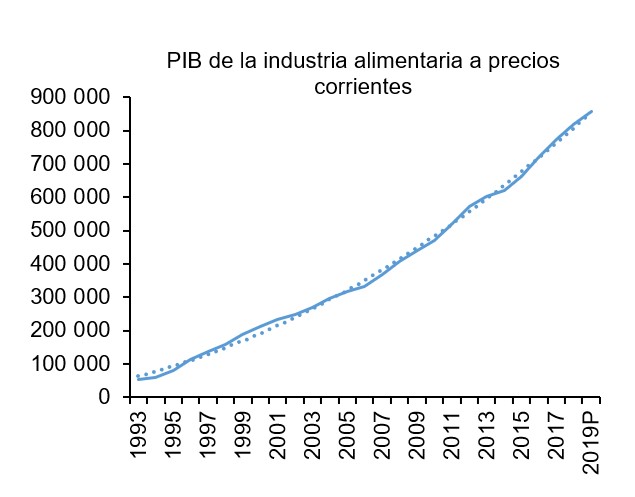Contribution of the Mexican food agroindustry to the gross domestic product during 1993-2019
DOI:
https://doi.org/10.29312/remexca.v14i7.2901Keywords:
average annual growth rate, growth, six-year periods, trendsAbstract
This research aimed to quantify the contribution of the Mexican food agroindustry to the national gross domestic product, as well as to calculate the average annual growth rate during a 27-year period from 1993 to 2019, which considered the last four six-year periods, and to determine the contribution to the manufacturing industry and the national economy. The methodology was documentary with the following stages: i) selection of the topic to be studied; ii) collection of information from secondary documentary sources, which was mainly from the national accounts of INEGI; iii) preparation of the research plan; iv) information organization, using the North American Industry Classification System of the National Institute of Geography and Informatics; and v) use of the statistical function, which for this case was the average annual growth rate. It was found that the food industry presented a positive trend throughout the period, with an average annual growth rate of 2.21% and with a parallelism with the manufacturing industry, which is the sector that encompasses the food industry; however, the latter presented some falls in its growth. The most relevant agroindustry in relation to the contribution of food GDP was the preparation of bread and tortilla with 30.15%, essential products of the basic basket in the diet of the people of Mexico. Finally, the food industry, on average for the period, contributes 22.42% of the manufacturing gross domestic product and 3.72% of the national product.
Downloads
References
Cavsi. 2022. ¿Qué y cuáles son las funciones estadísticas? cavsi.com/que-y-cuales-son-las-funciones-estadísticas-excel.
Coelho, A. M. y Castillo, G. V. M. 2010. Fusiones, adquisiciones y alianzas estratégicas en la industria alimentaria mexicana: balance y perspectivas. Revista Análisis Económico. 59(25):121-142.
Economipedia. 2022. Deflactor. economipedia.com/definiciones/deflactor.html.
Hernández, C. C. y Pérez, A. S. 2020. La industria alimentaria en México: comportamiento y distribución geográfica durante 1999-2014. Revista de Alimentación Contemporánea y Desarrollo Social. 30(56):1-33. Doi. 10.836/es.v30i56.1037.
Ibarra, L. S. 2016. Transición alimentaria en México. Universidad de los Hemisferios. Quito, Ecuador. Revista Razón y Palabra. 20(94):162-179.
INEGI. 2013. Instituto Nacional de Estadística, Geografía e Informática. Censos Económicos 2013. Aguascalientes. México, DF.
INEGI. 2014. Instituto Nacional de Estadística, Geografía e Informática. Censos Económicos. Aguascalientes, México, DF.
INEGI. 2019. Instituto Nacional de Estadística, Geografía e Informática. Censos Económicos. Aguascalientes, México, DF.
INEGI. 2020. Instituto Nacional de Estadística, Geografía e Informática. Sistema de Cuentas Nacionales de México. Cuentas de Bienes y Servicios. México, DF. https://www.inegi.org.mx/programas/pibact/2020/.
INEGI. 2020. Instituto Nacional de Estadística, Geografía Informática. Censo Población Vivienda 2020. https://www.inegi.org.mx/app/buscador/default.html?q=censo+de+ poblaci%C3%B3n+y+vivienda+2020.
INEGI. Instituto Nacional de Estadística, Geografía e Informática. 2013. Sistema de SCIAN. 2013. Clasificación Industrial de América del Norte. Aguascalientes. México, DF. 596 p.
Moctezuma, L. G. 2021. Contribución y evolución de las actividades industriales forestales al producto interno forestal (PIB) durante los tres sexenios anteriores: periodo 2001-2018. Revista Mexicana de Agronegocios. 25(48):630-641.
Moreno, P. A. R.; Cuevas, E. R. y Michi, S. L. T. 2018. Determinantes de la supervivencia empresarial en la industria alimentaria de México 2003-2008. Trayectorias. Universidad Autónoma de Nuevo León. Monterrey, NL. 17(41):3-28.
Navarrete, R. R.; Arredondo, M. H. y González, E. R. 2017. Revisión de la evolución de la industria alimentaria en México. Revista de Investigación y Desarrollo. 1(1):1-17.
Ríos, M. M. 2018. Responsabilidad social en la pequeña industria alimentaria en México: dos estudios de caso. RIGC. Universidad de Guanajuato. México, DF. 16(32):1-19.
Rodríguez, S. A. R. 2014. Herramientas para la competitividad de la pequeña empresa en América Latina. Málaga. Provincia de Málaga. España: Servicios Académicos Internacionales. http://www.eumed.net/libros-gratis/2014/1389/index.htm.
SADER. 2022. Secretaría de Agricultura y Desarrollo Rural. www.gob.mx/canastabasica.
SE. 2010. Secretaría de Economía. Industria alimentaria. Sección Políticas. México, DF. 9 p.
Solleiro, J. L. y Valle, M. C. 2003. Estrategias competitivas de la industria alimentaria. Universidad Nacional Autónoma de México. Centro de Ciencias Aplicadas y Desarrollo Tecnológico. Ed. Plaza y Valdez. 140 p.
Torres, F.; Trápaga, Y.; Gasca, J.; Rodríguez, S.; Rodríguez, D.; Oseguera, D.; Merino, A.; Chías, L.; Aguirre, J.; Escobar, M.; Pascual, P.; Gastelum, J.; Espinosa, J. A.; y Castro, I. 1997. Dinámica económica de la industria alimentaria y patrón de consumo en México. Universidad Nacional Autónoma de México. Instituto de Investigaciones Económicas. Distrito Federal. México, DF. 261 p.

Published
How to Cite
Issue
Section
License
Copyright (c) 2023 Revista Mexicana de Ciencias Agrícolas

This work is licensed under a Creative Commons Attribution-NonCommercial 4.0 International License.
The authors who publish in Revista Mexicana de Ciencias Agrícolas accept the following conditions:
In accordance with copyright laws, Revista Mexicana de Ciencias Agrícolas recognizes and respects the authors’ moral right and ownership of property rights which will be transferred to the journal for dissemination in open access. Invariably, all the authors have to sign a letter of transfer of property rights and of originality of the article to Instituto Nacional de Investigaciones Forestales, Agrícolas y Pecuarias (INIFAP) [National Institute of Forestry, Agricultural and Livestock Research]. The author(s) must pay a fee for the reception of articles before proceeding to editorial review.
All the texts published by Revista Mexicana de Ciencias Agrícolas —with no exception— are distributed under a Creative Commons License Attribution-NonCommercial 4.0 International (CC BY-NC 4.0), which allows third parties to use the publication as long as the work’s authorship and its first publication in this journal are mentioned.
The author(s) can enter into independent and additional contractual agreements for the nonexclusive distribution of the version of the article published in Revista Mexicana de Ciencias Agrícolas (for example include it into an institutional repository or publish it in a book) as long as it is clearly and explicitly indicated that the work was published for the first time in Revista Mexicana de Ciencias Agrícolas.
For all the above, the authors shall send the Letter-transfer of Property Rights for the first publication duly filled in and signed by the author(s). This form must be sent as a PDF file to: revista_atm@yahoo.com.mx; cienciasagricola@inifap.gob.mx; remexca2017@gmail.
This work is licensed under a Creative Commons Attribution-Noncommercial 4.0 International license.


